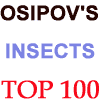|
 |
Ceratomia amyntor
WO,
the Elm Sphinx or Four-horned Sphinx |
 | Ceratomia catalpae WO, the Catalpa Sphinx
The upperside of the forewing is yellowish brown with no white
markings, but there are indistinct black lines and dashes. The cell
spot is gray with a black outline and the upperside of the hindwing
is yellowish brown with obscure lines. |
 |
Ceratomia hageni WO, Hagen's Sphinx or Osage Orange SphinxThe upperside of the forewing is gray with a green tint and has dark indistinct wavy lines, and pale gray patches at the wing tip and along the costa. |
 | Ceratomia undulosa WO,, the Waved SphinxThe upperside of the forewing is pale brownish gray with wavy black and white lines and a black-outlined white cell spot. |
 | Lintneria eremitus WO, the Hermit SphinxThe upperside of the forewing is gray-brown with wavy lines, black dashes, and one or two small white spots near the center of the costa. |
 | Manduca quinquemaculatus WO, the Five-spotted HawkmothThis large bodied moth flies in tobacco fields and vegetable gardens (potatoes, tomatoes) and wherever host plants are found. |

| Manduca sexta WO, the Carolina Sphinx
The upperside of the hindwing is banded with black and white and has
two black zigzag median lines that are very close together with
hardly any white showing between them |
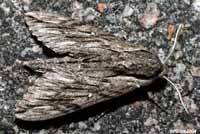 | Paratrea plebeja WO, the Plebeian SphinxThe upperside of the forewing is gray with indistinct black and white markings. There is a series of black dashes from the base to the tip, and a small white cell spot. |
 | Sphinx chersis WO, the Northern Ash Sphinx or Great Ash SphinxThe upperside of the forewing is soft dark gray to blue-gray with a series of black dashes, one of which reaches the wing tip. |
 | Sphinx drupiferarum WO, the Wild Cherry Sphinx
Forewings, long and slender, are held close to the body when the moth is at rest. We have them on P.E.I., but I do not see them nearly as frequently as I see the other Sphingidae. |
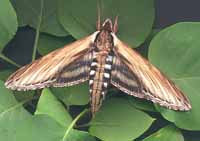 | Sphinx kalmiae WO, the Laurel SphinxThe lower forewings are predominantly brownish-yellow with a fairly wide dark bar along the inner margin. At rest the wings hug the body, giving the moth a long slender look. |
 |
Sphinx vashti WO, Snowberry Sphinx, |
Smerinthini Tribe:
 | Amorpha juglandis WO, the Walnut Sphinx
The adults are also highly variable; sometimes wings of an individual
may be all one color or may have several colors, ranging from pale to
dark brown, and may have a white or pink tinge. |
 | Pachysphinx modesta; WO, the Modest Sphinx or Poplar Sphinx,This moth has a large, heavy body, and females can be remarkably plump. |
 | Paonias excaecata WO, the Blinded Sphinx,The outer margin of the forewing is quite wavy. There is a dark cell spot and a dark oblique line mid wing from the costa almost to the inner margin. Basic ground colour is pinkish brown. Flight would be June-July. |
 | Paonias myops WO, the Small-eyed SphinxThis small species is probably widespread and common. This species ranges across North America. The hindwings have a small blue eyespot ringed with black on a yellow background. |
 | Smerinthus jamaicensis WO, the Twin-spotted SphinxThis moth is widely distributed and fairly common. Along the East Coast, it flies from P.E.I. to Florida. |
Macroglossinae subfamily
Dilophonotini Tribe:
See Hemaris comparison
to help distinguish the next three species.

Hemaris diffinis
WO/BAMONA, the Snowberry Clearwing or Bumblebee Moth,
The moth flies along forest edges and in meadows, gardens and
brushy fields. Day-flying adults nectar at lantana, dwarf bush honeysuckle,
snowberry, orange hawkweed, thistles, lilac, Canada violet, etc.

Hemaris thysbe
WO, the Hummingbird Clearwing
This interesting day flier is not confirmed for Winneshiek.
They are widely distributed in the east from P.E.I. to Florida.
Philampelini Tribe:

Eumorpha achemon
WO,
the Achemon Sphinx
This moth is not reported for Greene County, but I suspect it is present. It is fairly often
reported along the east coast from southern New Jersey
to central Maine.
Note the differences between this moth and the Pandorus Sphinx.

Eumorpha fasciatus
fall migrant/BAMONA, Banded Sphinx
Dark pinkish brown. Each forewing has a
lighter brown band along the costa, and sharp pinkish white bands and
streaks. Larvae feed upon primrose-willow, Ludwigia (water primrose)
and other plants in the evening primrose family.
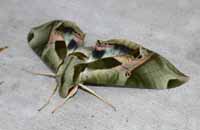
Eumorpha pandorus
TJBAMONA, the
Pandorus Sphinx
If you have Grape or Virginia Creeper nearby, then you probably have
this species. I often get asked to identify larvae from areas where
they have not previously been reported.
Eumorpha pandorus, July 26, 2013; Thomas Jantscher.
 | Hemaris diffinis WO/BAMONA, the Snowberry Clearwing or Bumblebee Moth,The moth flies along forest edges and in meadows, gardens and brushy fields. Day-flying adults nectar at lantana, dwarf bush honeysuckle, snowberry, orange hawkweed, thistles, lilac, Canada violet, etc. |
 |
Hemaris thysbe
WO, the Hummingbird Clearwing
|
Philampelini Tribe:
 |
Eumorpha achemon
WO,
the Achemon Sphinx |
 |
Eumorpha fasciatus
fall migrant/BAMONA, Banded Sphinx |
 |
Eumorpha pandorus
TJBAMONA, the
Pandorus Sphinx |
Macroglossini Tribe:
 |
Amphion floridensis
WO, Nessus Sphinix |
 |
Darapsa myron
WO, the Virginia Creeper Sphinx or the
Grapevine Sphinx |
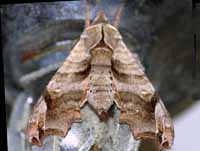 |
Deidamia inscriptum
WO,
the Lettered Sphinx |
 |
Hyles euphorbiae
WO, questionable, the Spurge Hawk Moth
|
 | Hyles gallii WO, the Bedstraw Hawk Moth or Gallium Sphinx
Some years I see them on P.E.I., some years, I do not. |
 | Hyles lineata TJ/BAMONA, the White-lined SphinxAdults usually fly at dusk, during the night, and at dawn, but they also fly during the day over a wide variety of open habitats including deserts, suburbs, and gardens. |
 | Sphecodina abbottii WO, the Abbott's SphinxThis moth is very much under reported on USGS. It is a rapid day flier so is probably not in too many collections. Grape is a popular larval host. |
